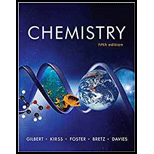
Interpretation: The bond length of
Concept introduction: The bond length is the distance between the nuclei of two bonded atoms. The bond length is in inverse proportion with the number of bonded electrons higher the number of bonded electrons shorter would be the bond length.
To determine: The bond lengths of
Answer to Problem 9.112QP
If the bond order of an anion is higher than its corresponding neutral molecule then, the anion has shorter bond length then its corresponding molecule.
Explanation of Solution
Explanation
Whenever the bond order of the molecular anion is greater than its corresponding species, the bong lengths of their species is reduced. The electronic configuration and bond order of anions and their corresponding neutral species is given in table below.
| Molecular species | Electronic configuration | Bond order |
|
|
|
|
|
|
|
|
|
|
|
|
|
|
|
|
|
|
|
|
|
|
|
|
|
|
|
|
|
|
|
|
|
|
|
|
|
|
|
|
|
|
|
|
|
|
|
|
|
|
|
|
|
|
|
|
|
|
|
|
Hence, from the table the bond orders of anions of carbon and boron molecule is higher than their corresponding molecules. Therefore their anions will have shorter bond length then the neutral species.
The anions of oxygen, nitrogen and fluorine molecules have bond orders lower than their corresponding neutral molecules. So their bond lengths are not shorter than their neutral molecules.
The
Want to see more full solutions like this?
Chapter 9 Solutions
CHEMISTRY:SCI.IN CONTEXT (CL)-PACKAGE
 ChemistryChemistryISBN:9781305957404Author:Steven S. Zumdahl, Susan A. Zumdahl, Donald J. DeCostePublisher:Cengage Learning
ChemistryChemistryISBN:9781305957404Author:Steven S. Zumdahl, Susan A. Zumdahl, Donald J. DeCostePublisher:Cengage Learning ChemistryChemistryISBN:9781259911156Author:Raymond Chang Dr., Jason Overby ProfessorPublisher:McGraw-Hill Education
ChemistryChemistryISBN:9781259911156Author:Raymond Chang Dr., Jason Overby ProfessorPublisher:McGraw-Hill Education Principles of Instrumental AnalysisChemistryISBN:9781305577213Author:Douglas A. Skoog, F. James Holler, Stanley R. CrouchPublisher:Cengage Learning
Principles of Instrumental AnalysisChemistryISBN:9781305577213Author:Douglas A. Skoog, F. James Holler, Stanley R. CrouchPublisher:Cengage Learning Organic ChemistryChemistryISBN:9780078021558Author:Janice Gorzynski Smith Dr.Publisher:McGraw-Hill Education
Organic ChemistryChemistryISBN:9780078021558Author:Janice Gorzynski Smith Dr.Publisher:McGraw-Hill Education Chemistry: Principles and ReactionsChemistryISBN:9781305079373Author:William L. Masterton, Cecile N. HurleyPublisher:Cengage Learning
Chemistry: Principles and ReactionsChemistryISBN:9781305079373Author:William L. Masterton, Cecile N. HurleyPublisher:Cengage Learning Elementary Principles of Chemical Processes, Bind...ChemistryISBN:9781118431221Author:Richard M. Felder, Ronald W. Rousseau, Lisa G. BullardPublisher:WILEY
Elementary Principles of Chemical Processes, Bind...ChemistryISBN:9781118431221Author:Richard M. Felder, Ronald W. Rousseau, Lisa G. BullardPublisher:WILEY





